Fall 2023
Volume 16 Issue 2
Articles in this issue:
- Douglass Jacobs Co-leader on Assessment of At-Risk Forest Trees
- Annual Report Available for 2022
- Tour and Annual Meeting for HTIRC
- Indiana Conservation Partnership Training
- HTIRC Participates in Walnut Council Annual Conference
- Purdue FNR and HTIRC Property Tours
- Shaneka Lawson Recognized with National Awards
- Forgey Wins "Sagamore of the Wabash" Award
- New Administrative Assistant for HTIRC
- Rice Grant from Purdue Allows HTIRC to Acquire Tree Seed Harvester
- The HTIRC 2023 Seed Harvest
- Landowners and Land Managers - New Opportunities for Assistance
Douglass Jacobs Co-leader on Assessment of At-Risk Forest Trees
Douglass Jacobs of the HTIRC and Kasten Dumroese of the U.S. Forest Service led a team of 19 co-authors, including scientists, land managers and regulators, in presenting their findings on biotechnological risk assessment and forest tree restoration. Their New Forests paper, published in a special issue on threatened tree species, presents key outcomes of a 2021 virtual international conference on the issues.
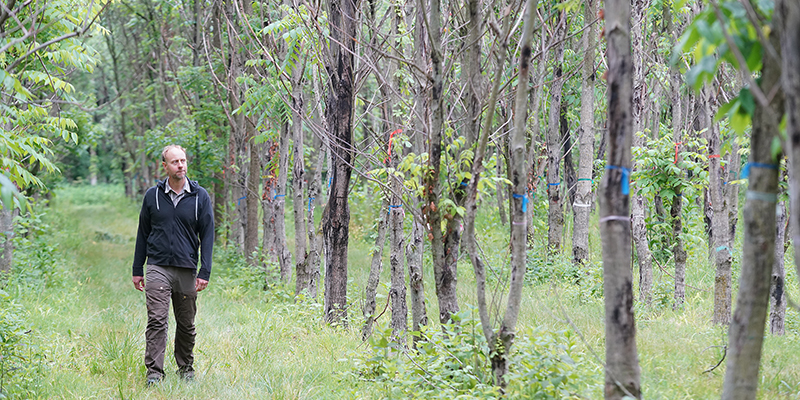
Among their conclusions, a main one was that society drives policy and, if genetic engineering is the only way to save some species, its use will require public acceptance.
“Biotechnology is a diverse toolkit comprising different technologies that can be used to impart pest resistance – it could be insects or pathogens – in our threatened forest trees,” said Jacobs, the Fred M. van Eck Professor of Forest Biology. But many people mistakenly equate biotechnology with genetic engineering. “Traditional tree breeding, whether you’re breeding different species or different varieties within species, has been going on for thousands of years. And, the regulations on planting trees that have been traditionally bred are wide open,” he said. “Genetic engineering, on the other hand, is highly regulated, but all biotechnology is certainly not genetic engineering.” “For some species, traditional tree breeding doesn’t appear to be a viable long-term option to get disease-resistant trees. In those cases, it’s probably going to have to be genetic engineering if we want to save the species,” he said.
Excerpts taken from an article by Steve Koppes, Purdue University Department of Agricultural Communications. The full article is available at Biotechnology offers holistic approach to restoration of at-risk forest tree species – Purdue University News.
Visit the HTIRC News Archive for news and recent research publications: News Archive
Annual Report Available for 2022
The annual report outlining HTIRC research projects, strategic directions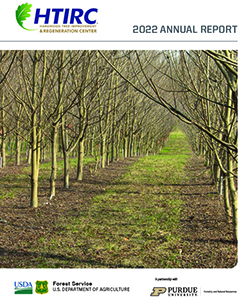 and accomplishments is now available on the HTIRC website at Annual Report. The report provides updates on the progress of HTIRC-funded projects, our breeding programs that address forest health and quality, and extension and engagement activities that connect our work with a variety of audiences, and educational activities that develop student skills to continue this work into the future. Please take some time to review the diverse ways HTIRC is addressing the challenges facing hardwood forest health, management and regeneration.
and accomplishments is now available on the HTIRC website at Annual Report. The report provides updates on the progress of HTIRC-funded projects, our breeding programs that address forest health and quality, and extension and engagement activities that connect our work with a variety of audiences, and educational activities that develop student skills to continue this work into the future. Please take some time to review the diverse ways HTIRC is addressing the challenges facing hardwood forest health, management and regeneration.
The next strategic plan for the HTIRC is heading to the printer and will be available online at Strategic Plan in the near-future. This report, developed in conjunction with our Advisory Committee and supporters, will guide our activities for the next five years, providing continuity and strategic direction for our efforts.
Tour and Annual Meeting for HTIRC
HTIRC staff, students, Advisory committee members, partners and supporters met on February 24, 2023 at the John S. Wright Center and Martell Forest west of the Purdue University West Lafayette campus. Presentations on HTIRC research projects and strategic directions were provided by researchers, graduate students and staff, demonstrating the research extension, and education mission of the center. Participants also toured a butternut planting to learn more about disease resistance breeding of butternut and hybrid butternut from HTIRC scientists and staff, including Anna Conrad, Doug Jacobs, Caleb Kell, and Aziz Ebrahimi. The HTIRC has a long-term project collecting and evaluating butternut and its’ hybrids and their relative resistance to butternut canker in hopes of providing an opportunity for restoration of this valuable but declining hardwood tree.

Indiana Conservation Partnership Training
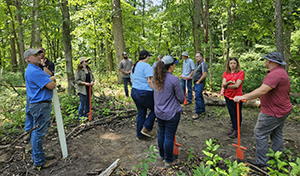
In August of 2023, Extension and Property Management staff from HTIRC and Purdue Forestry and Natural Resources provided hands-on training days at the Purdue FNR Martell Forest and Southeast Purdue Ag Center properties for members of the Indiana Conservation Partnership, including USDA NRCS, Indiana SWCD, Indiana DNR, and Purdue Extension employees. The training focused on challenges to successfully establishing artificial and natural regeneration of desirable species like oaks and black walnut, with special attention to reducing deer damage to improve tree regeneration.
Presentations, a flash drive loaded with relevant references and resources, and hands-on field exercises in tree planting and tree protection methods and challenges provided a broad overview of options to improve planting success. Participants in this training work with landowners and agencies across the region providing expanded delivery of our research and extension products and experiences. In addition, these practices and programs can influence policy related to USDA and other landowner conservation programs, leading to more effective and successful practices in the field.
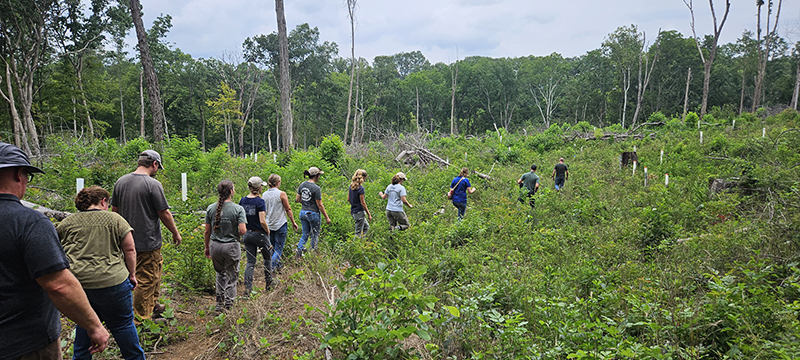
HTIRC Participates in Walnut Council Annual Conference

Several members of the HTIRC staff helped organize and presented at the annual National Walnut Council conference in Columbia, Missouri in July or 2023. Liz Jackson is the Executive Director for the Walnut Council and provides guidance and assistance to the local organizing committee for each conference. This year was a unique event with three organizations joining forces for an impressive array of presentations an field tours. Walnut Council, Northern Nut Growers, and Chestnut Growers of America met on the University of Missouri campus and surrounding field locations for the four-day event. Presentations from HTIRC staff were provided by Matt Ginzel, Shaneka Lawson, and Lenny Farlee. This annual conference is an important engagement opportunity with current and potential consumers of our research and tree breeding work.
Purdue FNR and HTIRC Nelson-Stokes-Lewman Property Tour
Purdue FNR and HTIRC staff led a tour at the Purdue Nelson-Stokes-Lewman property for the September Indiana Society of American Foresters meeting. Nelson-Stokes-Lewman is an actively managed forest property with plantings and native forest area of a variety of ages and types. Silvicultural experiments demonstrating planting of American chestnut and other hardwoods in a variety of harvest types were presented by Michael Saunders, Purdue Professor of Silviculture. These experiments will help us to understand the dynamics between the growth of chestnut and other hardwoods in a variety of management practices. The growth rate of American chestnut can be exceptional compared to other upland hardwood species, so understanding how it competes with other desirable tree species will help formulate management recommendations when blight-resistant chestnut is available for out-planting.
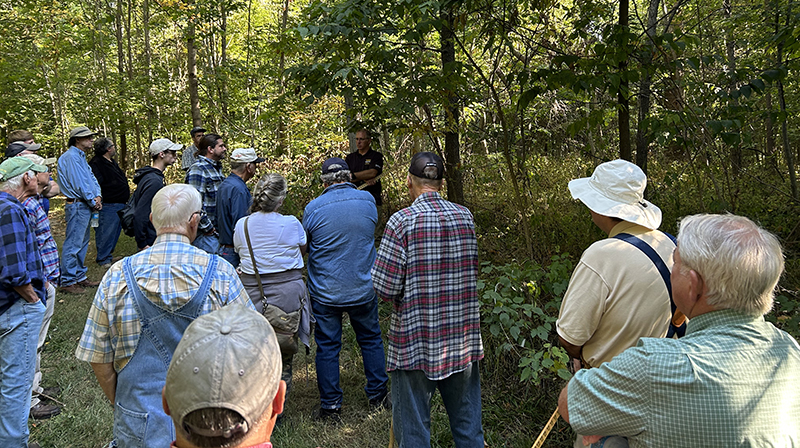
Purdue Property Manager Brian Beheler and Extension Foresters Ron Rathfon and Lenny Farlee introduced a variety of management practices and past harvest areas and led discussions on management options to consider. The audience represented a cross-section of public, private and industry foresters and provided an excellent opportunity to demonstrate some research and management practices and get feedback from practicing foresters. These opportunities to bring together research and practicing professionals can provide learning opportunities for both audiences – the foresters are exposed to research results on the ground and researchers learn about the challenges and logistical questions faced by field foresters and how the research and management application can inform the development of each area.
On September 23, 2023 a forestry tour was held at the Purdue Harrold property in Whitley County with 22 landowners in attendance. Purdue forester Don Carlson toured the group through a very large 25-year-old clearcut. The discussion focused on management of this large even-aged stand, including timber stand improvement, crop tree selection, and subsequent oak and walnut enrichment plantings and storm damage results. There was also discussion on spotted lanternfly and a stop at some natural butternuts.

Shaneka Lawson Recognized with National Awards
Shaneka Lawson, Research Plant Physiologist in the USDA Forest Service Northern Research Station (NRS) Hardwood Tree Improvement and Regeneration Center (HTIRC) and an adjunct assistant professor in Purdue University Department of Forestry and Natural Resources, has been selected as the recipient of a 2023 USDA Forest Service NRS Station Director’s Award in the category of “Excellence in Equity Action” for her efforts and contributions to the Forest Service and research community.

In addition, further congratulations to Shaneka for receiving the Community Service Award at the 2023 Women of Color STEM DTX Conference organized by the Women of Color magazine. Shaneka was presented with the award at the Women of Color Awards Ceremony on October 14, 2023. This black-tie recognition ceremony came with a speech on stage, a TV interview, and a write-up in the organizations’ magazine. The full announcement of the awards can be found at
Shaneka Lawson Honored for Equity Efforts, Community Service (purdue.edu)
Forgey wins “Sagamore of the Wabash” award!
By: Shaneka Lawson
Michael Forgey, a resident of New Palestine and a seasoned Rush County farmer, was honored with the prestigious “Sagamore of the Wabash” award by Governor Eric Holcomb  at the Forgey Tree Farm in Rush County, Indiana on November 1, 2023. This award was given in recognition of his valuable research contributions to improve our region’s hardwood forests. Starting in 2009, the Forgey family partnered with Purdue University’s Hardwood Tree Improvement and Regeneration Center (HTIRC) to establish a notable 100-acre tree plantation, showcasing tree breeding programs of black walnut, black cherry, red oak, white oak, butternut, and American chestnut.
at the Forgey Tree Farm in Rush County, Indiana on November 1, 2023. This award was given in recognition of his valuable research contributions to improve our region’s hardwood forests. Starting in 2009, the Forgey family partnered with Purdue University’s Hardwood Tree Improvement and Regeneration Center (HTIRC) to establish a notable 100-acre tree plantation, showcasing tree breeding programs of black walnut, black cherry, red oak, white oak, butternut, and American chestnut.
The award was presented by Indiana State Representative Bob Cherry and retired State Senator Bob Jackman on behalf of Governor Eric Holcomb, honoring those who have made distinguished contributions to the state. The Forgeys express their gratitude for the support of family, friends, Purdue University, local Agricultural Services (ASCS), and elected officials. In addition to this recognition, in 2011, Mike Forgey was named a “Distinguished Hoosier” by Governor Mitch Daniels for his work in senior healthcare and housing, and in 2015, he received the Rush County Conservation Farmer Award. For more information or to arrange a tour, contact Michael Forgey by email at mlforgeyfarm@comcast.net or visit Forgey Tree Farm on Facebook.
New Administrative Assistant Joins HTIRC
Heather grew up in a small town in Illinois and moved to Lafayette about 8 years ago. Upon graduation from high school, she attended Saint Joseph’s College in Rensselaer. She has twins who are four named Osprey and Sparrow, a girl and a boy. In her free time, she enjoys reading all types of books, watching historical or horror shows and movies, and being outside as much as possible. Her background is in a variety of office settings. A few of her favorite things about working in an office is getting to showcase her organizational skills, being creative, and helping professionals deal with day-to-day operations so they can focus on their passions. You can find her contact information in the Staff Directory.
Rice Grant from Purdue Allows HTIRC to Acquire Tree Seed Harvester
Caleb Kell, Operational Tree Breeder, and Matt Ginzel received a Purdue School of Agriculture Rice Grant to purchase a seed harvester. This 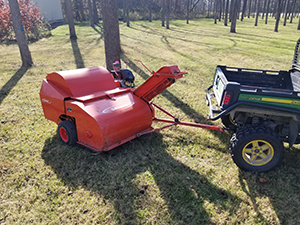 harvester will speed up the important but laborious job of collecting seeds like black walnut and butternut for the breeding program and seedling production. Investments like this specialized equipment and increasing use of technology for measurements and monitoring will save valuable staff time and increase our productive capacity in both research projects and breeding programs, as well as seed sharing with partners and cooperators.
harvester will speed up the important but laborious job of collecting seeds like black walnut and butternut for the breeding program and seedling production. Investments like this specialized equipment and increasing use of technology for measurements and monitoring will save valuable staff time and increase our productive capacity in both research projects and breeding programs, as well as seed sharing with partners and cooperators.
The HTIRC 2023 Seed Harvest
By Caleb Kell, Operational Tree Breeder
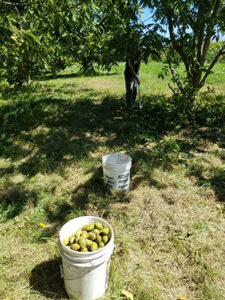
Seed production is a crucial component of the HTIRC’s improvement program, for without it there is no progeny testing or distribution of improved genetics to the public. This year, a droughty spring and early summer was followed by an unusually wet July, stimulating a bumper crop in the HTIRC’s orchards.
Black cherry orchards at the Lugar Farm produced enough seed to fill the Indiana Division of Forestry’s quota for its “select” black cherry, with extra seed left over to store for future needs. No black seed was sown for progeny testing this year due to a lack of sites for planting in 2025.
The HTIRC’s canker-resistant butternut breeding orchard occupied many days in September, with weekly trips taken to Pinney PAC to harvest before the squirrels do. With help from volunteers Bill Deeter and Jim McKenna, 17,000 disease-resistant butternut seeds were harvested from 24 different clones. At the Office Furniture Systems pure butternut conservation orchard in Huntingburg, IN, Forest Service employees from the Hoosier National Forest assisted with seed harvest, collecting 40,000 butternuts in a single day.
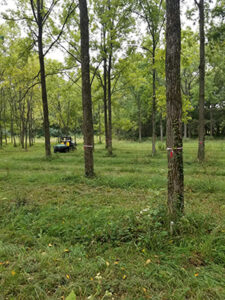
Black walnut, the HTIRC’s other Juglans species, also fruited prolifically. The black walnut clone banks at Martell were especially productive, and a mixed crew of HTIRC/FNR staff and undergraduate students harvested over 34,000 nuts for progeny testing, along with 200 bushels of walnuts for the Indiana Division of Forestry. Most of the families harvested for testing have never been progeny tested before, offering a unique opportunity to further evaluate the HTIRC’s diverse black walnut collection.
The American chestnut crop was modest, only totaling to about 5000 seeds. The decline of the Duke American chestnut orchard is in full swing due to chestnut blight, which finally gained the upper hand after 12 years of battle. Harvests of American chestnut are expected to recover in the future as newer, blight-free orchards reach bearing age. Owing to the poor state of the Duke block, no controlled crosses were made this year, a condition that should also improve in the future as young trees mature and local production of transgenic American chestnut pollen begins.
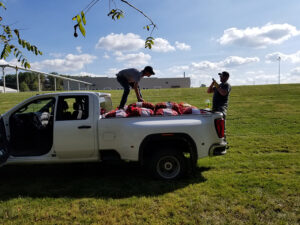 White oak bore heavily this fall, with a collected total of over 45,000 seeds. Some of the bark grafts made in 2019 also bore for the first time this year, further increasing the number of families available for progeny testing. The HTIRC’s Savage nut harvester didn’t arrive until October 16th, well after most of the white oak crop had fallen, but it made quick work of the latest ripening clones, harvesting several thousand acorns over the course of two hours.
White oak bore heavily this fall, with a collected total of over 45,000 seeds. Some of the bark grafts made in 2019 also bore for the first time this year, further increasing the number of families available for progeny testing. The HTIRC’s Savage nut harvester didn’t arrive until October 16th, well after most of the white oak crop had fallen, but it made quick work of the latest ripening clones, harvesting several thousand acorns over the course of two hours.
Most of the HTIRC’s surplus white oak, black cherry, black walnut, and canker-resistant butternut will be grown and sold by the Indiana Division of Forestry as ‘select’ grade seedlings. The HTIRC’s American chestnut and pure butternut crop will be grown by Hensler Nursery, who makes these threatened species available for planting nationwide.
Landowners and Land Managers – New Opportunities for Assistance
USDA Conservation programs that provide technical and cost assistance are a significant support mechanism for management practices on private woodlands and tree plantings. This resource was often hard to access due to significant competition for funding, resulting in only a fraction of practices funded each year. Some of that backlog of demand may be addressed as recent legislation has provided a new p
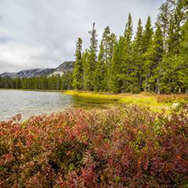 ulse of funding into conservation programs and practices relevant to many woodland and tree plantation owners. These practices could include tree planting, controlling undesirable or invasive plants, doing forest improvement practices like thinning and vine control, enhancing wildlife habitat, regenerating desirable tree communities like oak and hickory, and many other practices. Access to these programs is through your local USDA Service Center. The best way to see how these programs might fit into your property needs and goals is to schedule a visit with the conservation specialists in your county, or work with your professional forester to learn more. You can find your local USDA Service Center at https://www.usda.gov/partner-portal/find-usda
ulse of funding into conservation programs and practices relevant to many woodland and tree plantation owners. These practices could include tree planting, controlling undesirable or invasive plants, doing forest improvement practices like thinning and vine control, enhancing wildlife habitat, regenerating desirable tree communities like oak and hickory, and many other practices. Access to these programs is through your local USDA Service Center. The best way to see how these programs might fit into your property needs and goals is to schedule a visit with the conservation specialists in your county, or work with your professional forester to learn more. You can find your local USDA Service Center at https://www.usda.gov/partner-portal/find-usda
